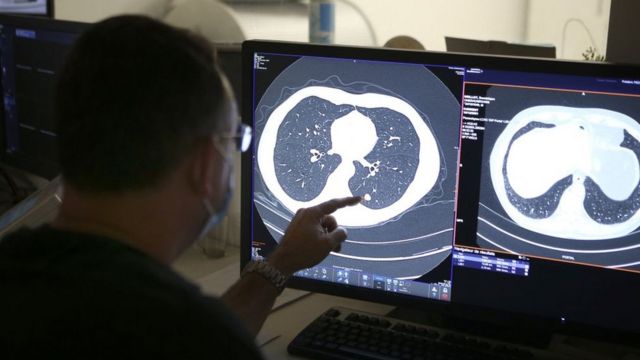Simone Barbosa, 67, has struggled to follow breast cancer screening recommendations issued by health care organizations for three decades.
A study by the World Health Organization concluded that mammograms for women aged 50 to 64 could reduce breast cancer deaths, but recommendations vary from country to country.
The site Breastcancer.org cites research in the UK that says these tests should start at 40 years of age.
The respected Mayo Clinic in the United States agrees that mammograms at this early age reduce the risk of dying from the disease. It is the age when Brazilian women are also recommended to start getting mammograms.
Knowing that the risk of disease increases with age, Simon included mammogram at your yearly checkup for a long time.
But in 2020, with several medical services temporarily suspended due to the high demand for treatment caused by covid-19, he was unable to perform those tests.
“I was already upset about the situation, so when things improved a bit in 2020, I gave it a go and soon got checked out,” says Simone.
The mammogram taken at the time showed a small lump in the breast, which, when biopsied, turned out to be a malignant tumour.
“After this diagnosis, as is usually done, we proceed with the staging of the cancer, that is, with the evaluation of the possible extension of the disease.
“In cases of breast cancers, the most common is that the metastases spread to the liver, bones and lungs, so we focus on studying those areas first.”
The surprise
This is explained by Leonidas Noronha, mastologist and oncoplastic surgeon who followed Simone’s case.
The surprise, says the doctor, is that a pulmonary nodule was found in the chest X-ray, one of the tests required for staging.
“Because this test is simple, you can’t tell just by looking at the picture whether the mass is from a primary tumor. [otro cáncer, no relacionado con el seno] or a metastasis.
After a tomographythe specialist received a picture of a large tumor, about four centimeters, which indicated that it was primary, which was confirmed by a subsequent biopsy.
“In over 30 years of mastology, Simone was the first patient in whom I saw breast and lung cancer at the same time.”
It’s called the condition of two cancers that are unrelated to each other, explains Noronha synchronous tumors and is considered quite rare.
“There is no single answer as to why this happens. It could be related to a genetic predisposition, but this could only be confirmed with a DNA sequencing test.”
Simone says the surprise of the two cancers was made even greater by having only one known case of cancer in her family: a sister who had bladder cancer. She, on the other hand, was a smoker, and smoking is the main risk factor for this type of cancer.
Simone says she was lucky to discover both cancers, especially the lung one, which is more difficult to treat and their symptom solo with manifystan when it is already very advanced.
“I have been very blessed. I truly believe God gave me breast cancer so I could see lung cancer. I didn’t have any symptoms, so I wouldn’t have been tested if it wasn’t for the first diagnosis.”
When lung cancer starts showing signs like shortness of breath, coughing, chest pain, and extreme weight loss, it means the disease is already in an advanced stage (and with a high likelihood of metastasis).
In Simon’s case, neither cancer had spread to other parts of the body.
Treatment of two different types of cancer
The mastologist states that the treatment plan was jointly decided by him, the patient, a clinical oncologist and a thoracic surgeon.
“Since chemotherapy had already been indicated due to the larger tumor size of the lung, we decided to start treatment in sessions.”
Then came breast surgery and finally lung surgery.
Using conventional surgical methods, removing a lung tumor requires a more advanced approach. invasive from the patient’s body, resulting in extensive surgery and a long recovery time.
“Since I was due to have two surgeries in a short time, I opted for the robotic lung surgery option, which the doctors explained would cause less pain and a quicker return to my routine,” says Simone.
According to Leonardo Rottili Roede, thoracic surgeon at the Marcelino Champagnat hospital in Curitiba, the surgery is minimally invasive and has no cuts, only fine incisionswhich suits the person who is interested in aesthetics.

What is done in surgery depends on the size of the lesion.
“Because Simone’s tumor was large, we removed one of the lung lobes, the upper left one,” Roede says.
“At first he lost some of his breathing capacity, but after the surgery, with rehabilitation and pulmonary physiotherapy, he recovered. Today he has reached a level very close to what he had before ”.
Simone’s last surgery turned one year old in November. Her current treatment involves taking an oral hormone blocker that helps reduce the chances of the breast cancer coming back.
“Today she is in remission from the cancer, but like any patient who has had the disease, she needs follow-up for several years,” says Noronhas, Simone’s doctor.
«When there is a diagnosis of breast cancer, but the staging shows that it is already metastatic, which was not the case for Simone, the way of thinking about the treatment changes», explains the mastologist.
Surgery no longer has an initial impact, as removing a tumor would not kill the cancer cells, which it does they would continue to spread.
“Attention generally becomes a systemic treatment such as immunotherapy, chemotherapy and monoclonal antibody drugs. It is a clinical and non-surgical line of care”.
The prognosis for metastatic cases is more difficult, but even if it is not possible to go into remission (being disease-free), patients with this condition often they have a good quality of lifesays Noronhas.
“With the new therapies we have today, patients with grade 4 breast cancer, for example, have active lives for many years, even more than a decade. A few years ago, the prognosis was much shorter.”
and the article was adapted from a text published on BBC News Brasil of which the Portuguese version is possible read here.


